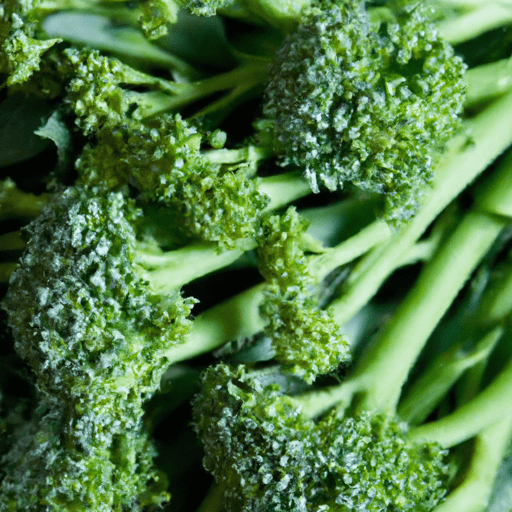Broccolini: A Delicate and Nutritious Vegetable
Broccolini, also known as “baby broccoli” or “asparation,” is a delicious and versatile vegetable that has been gaining popularity in recent years. With its slender stalks and small florets, broccolini is a cross between broccoli and Chinese kale, resulting in a unique flavor and tender texture. In this blog post, we will dive deeper into the world of broccolini, exploring its taste, common uses in cooking, nutritional value, and some fascinating history and facts.
Taste and Texture
Broccolini is known for its mild and slightly sweeter taste compared to regular broccoli. Its florets have a delicious earthy flavor, while the thin stalks offer a delicate crunch. This combination of flavors and textures makes broccolini a delight to cook with, as it pairs well with various ingredients and cooking methods.
Cooking Uses
One of the great things about broccolini is its versatility in the kitchen. It can be used in a wide range of dishes and cooking styles, from quick stir-fries to roasted side dishes. Here are a few popular ways to enjoy broccolini:
Stir-Fries: Broccolini’s tender texture makes it an excellent addition to stir-fries. Its thin stalks cook quickly and evenly when sautéed with other vegetables, meats, or tofu. The mild flavor of broccolini allows it to absorb the flavors of the other ingredients in the dish, making it a versatile and complementary addition to any stir-fry.
Grilling and Roasting: Grilling or roasting broccolini can bring out its natural sweetness and create a slightly charred flavor. Toss it with olive oil, sprinkle with salt and pepper, and grill or roast until it becomes tender-crisp. This method adds a delightful smokiness to the vegetable, making it a perfect side dish for grilled meats or a delicious addition to pasta dishes.
Steaming and Blanching: Steaming or blanching broccolini helps retain its vibrant green color and enhances its tender texture. Serve it as a simple side dish, toss it into salads, or use it as a topping for pizzas and sandwiches. The possibilities are truly endless!
Nutritional Value
Broccolini not only offers a delightful culinary experience but also packs a punch in terms of nutrition. Just like its relatives, broccoli and kale, broccolini is rich in vitamins, minerals, and antioxidants. Here are some key nutritional highlights:
Vitamin C: Broccolini is an excellent source of vitamin C, a powerful antioxidant that boosts the immune system and supports overall health.
Vitamin A: This vegetable is also a good source of vitamin A, which is essential for maintaining healthy vision and promoting proper cell growth.
Fiber: Broccolini contains dietary fiber, which aids in digestion and helps keep you feeling full and satisfied.
Calcium and Iron: While broccolini may not be as high in calcium and iron as some other vegetables, it still provides a valuable amount of these essential minerals.
Fascinating History and Facts
Broccolini may seem like a relatively new vegetable, but its origins can be traced back to the late 1990s. It was first developed by crossing regular broccoli with Chinese kale, resulting in a tastier and more tender variety. This process led to the creation of broccolini, which quickly gained popularity due to its unique flavor profile and versatility in cooking.
Although broccolini is often mistaken as a young broccoli plant, it is, in fact, a separate vegetable with its own distinct characteristics. Its small florets and long, slender stalks set it apart from its broccoli cousin.
In Conclusion
Broccolini is undoubtedly a gem in the world of vegetables. With its delicate flavor, tender texture, and numerous culinary possibilities, it has become a favorite ingredient among chefs and home cooks alike. Whether you choose to stir-fry, grill, or steam it, broccolini is sure to bring a touch of elegance and nutrition to your next meal. So why not give this delightful vegetable a try and explore the many delightful ways it can elevate your cooking?
Broccolini
Origin: Broccolini, also known as baby broccoli, is a hybrid vegetable that was developed by crossing broccoli with Chinese kale. It was first created in 1993 by a team of breeders at the Sakata Seed Company in Japan. Broccolini was later introduced to the United States in the late 1990s and has since gained popularity.
Common Uses: Broccolini can be used in a variety of ways in cooking. Its tender stalks and florets make it a versatile ingredient that can be steamed, sautéed, roasted, or even grilled. It is often used as a side dish, added to stir-fries, pasta dishes, salads, or included in vegetable medleys.
Nutritional Benefits: Broccolini is a nutrient-dense vegetable that provides several health benefits. It is an excellent source of vitamins A and C, both of which are antioxidants that help protect the body against cell damage. Broccolini is also a good source of dietary fiber, potassium, calcium, and iron. Additionally, it contains compounds called glucosinolates, which have been linked to potential anti-cancer effects.
Unique Properties: One of the unique properties of broccolini is its milder and sweeter taste compared to regular broccoli. It has a delicate flavor with hints of asparagus and broccoli. Another characteristic of broccolini is its long, thin stalks and small florets, which resemble a miniature version of broccoli. Its tender texture makes it quicker to cook compared to regular broccoli.
Historical Significance: Broccolini is a relatively recent addition to the vegetable world. Its creation was a result of ongoing plant breeding efforts to develop new and unique varieties of vegetables. Since its introduction, broccolini has gained popularity due to its attractive appearance, flavor, and versatility in cooking. Nowadays, it can be found in many supermarkets and farmers markets worldwide, making it easily accessible to consumers.




Use the share button below if you liked it.
It makes me smile, when I see it.